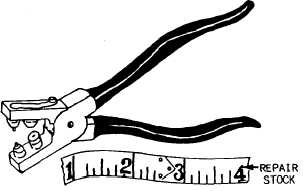operations in which mistakes are possible. Some
of the more common mistakes are as follows:
. Failing to hold graduations plumb over
p o i n ts
. Involuntarily transposing figures, such as
recording 48.26 for 48.62
l Misreading figures that are viewed upside
down, such as recording an upside-down 9 as a 6
. Reading a subdivided end-foot from the
wrong end, as, for example, 0.28 ft instead of 0.22
ft
. Associating subdivided end-foot reading
with wrong whole-foot mark, as 38.21 ft instead
of 37.21 ft
. Subtracting incorrectly when using a minus
tape
. Omitting an entire tape length
RECOGNIZING COMMON ERRORS.—
There are two types of errors: accidental and
systematic.
An accidental error is, generally speaking, one
that may have a varying value. Examples are as
follows: variation of the tension applied to
the tape, inaccurate sticking of pins or other
markings, and inaccurate determination of slope.
Accidental errors can be minimized by careful-
ness, but not entirely eliminated.
A systematic error has a constant value.
The standard error in a tape, for example,
is a systematic error. Temperature and sag
corrections are applied to correct systematic
errors. Systematic errors can be compensated for
or otherwise eliminated by the application of
corrections.
Caring for and Maintaining a Survey Tape
If a steel or metallic tape gets a kink in it, it
is then subjected to strain. The tape at best will
be distorted at the point where the kink lies. At
worst, if the strain is strong enough, the tape will
break at the point where the kink lies. Kinks,
therefore, are to be avoided at all costs; it is
especially important to avoid putting a strain on
a tape with a kink in it.
Under favorable circumstances, when a tape
is shifted ahead, the head chainman may simply
drag it over the ground. It is not a good idea for
the rear chainman to assist by dragging that end
because this develops a curve in the tape. This
curve may snag on an obstruction and also may
be the cause of a kink. When a tape is being
dragged, the rear chainman should simply allow
the end to trail along. The cardinal rule is “keep,
the tape straight.”
When taping in traffic, you plan your moves
in advance and make the measurement as fast as
possible. If possible, do not let vehicles run
over the tape; however, if this is absolutely
unavoidable, be sure the tape is laid flat and taut
on the road. NEVER let a vehicle run over a tape
laid on a soft or rugged ground surface.
Tapes are made as corrosion-resistant as
possible, but no steel tape is entirely immune to
corrosion, especially when used around salty
water. Therefore, a tape should always be wiped
dry before it is put away, and it should be oiled
periodically with a light, rust-resistant oil. If a tape
does rust, rubbing it with light steel wool dipped
in a rust-removing compound is the best and safest
way to remove the rust. Tapes, especially those
in reels, though not used during the week, should
be removed from the reel and inspected each week
for signs of corrosion. A damp climate in your
area of operations could easily start corrosion in
tapes.
Splicing a Tape
In spite of being carefully handled, tapes
sometimes break. A broken tape is rejoined by
splicing. A relatively light tape can be repaired
with a punch-and-rivet tape splicer and repair
stock (fig. 12-22). A repair stock consists of a
Figure 12-22.-A punch-and-rivet tape splicer with repair
stock.
12-23



